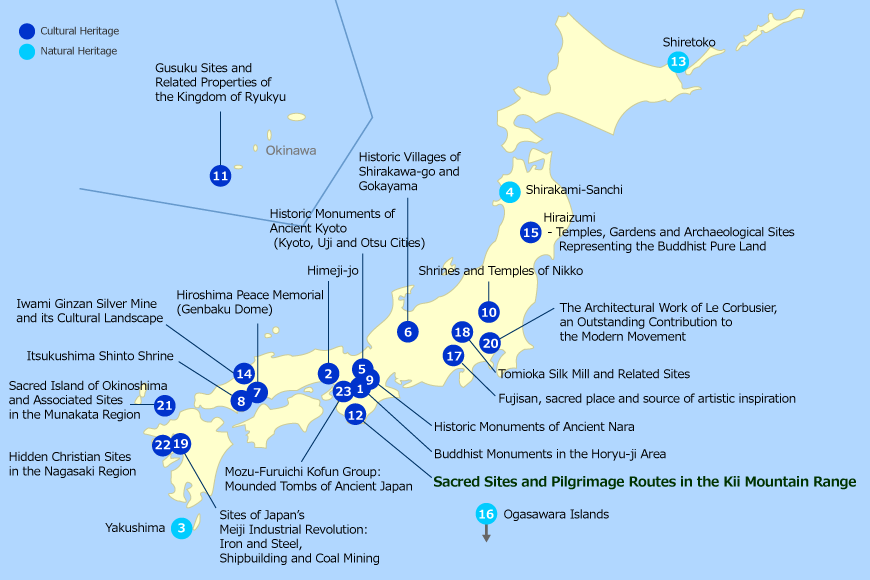World Heritage
World Heritage Sites are the ones inscribed in the World Heritage List based upon the "Convention Concerning the Protection of the World Cultural and Natural Heritage (socalled the World Heritage Convention) adopted in 1972 by the General Conference of UNESCO. "Site","Buildings" and "Nature" inscribed on this list have to be preserved and protected "internationally" as valuable and common assets of mankind.
The first condition for the inscription to the World Heritage is that the World Heritage Committee admits that the property has a unique and "remarkable and universal value" based on an international standard. And it is necessary that the property is well reserved and managed suitably for its value.
In July 2019, 1121 sites in the world and 23 sites in Japan are inscribed on the list. As the number of sites increased, it was ruled that one country should not have the same kind of property recommended. In this sense, those inscribed now are the representatives of the history, culture and nature of the country all over the world.
| No | Property | Prefecture | Year Inscribed | Standard of value |
|---|---|---|---|---|
| 1 | Buddhist Monuments in the Horyuji Area Nara | Nara | 1993 | 1,2,4,6 |
| 2 | Himeji-jo | Hyogo | 1993 | 1,4 |
| 3 | Yakushima | Kagoshima | 1993 | 8,9 |
| 4 | Shirakami-Sanchi | Aomori / Akita | 1993 | 8 |
| 5 | Historic Monuments of Ancient Kyoto, Uji and Otsu Cities | Kyoto / Shiga | 1994 | 2,4 |
| 6 | Historic Villages of Shirakawa-go and Gokayama | Gifu / Toyama | 1995 | 4,5 |
| 7 | Itsukushima Shinto Shrine | Hiroshima | 1996 | 1,2,4,6 |
| 8 | Hiroshima Peace Memorial (Genbaku Dome) | Hiroshima | 1996 | 6 |
| 9 | Historic Monuments of Ancient Nara | Nara | 1998 | 2,3,4,6 |
| 10 | Shrines and temples in Nikko | Tochigi | 1999 | 1,4,6 |
| 11 | Gusuku Site and Related Properties of the Kingdom of Ryukyu | Okinawa | 2000 | 2,3,6 |
| 12 | Sacred Sites and Pilgrimage Routes in the Kii Mountain Range | Mie / Nara / Wakayama | 2004 | 2,3,4,6 |
| 13 | Shiretoko | Hokkaido | 2005 | 8,10 |
| 14 | Iwami Ginzan Silver Mine and its Cultural Landscape | Shimane | 2007 | 2,3,5 |
| 15 | Hiraizumi - Temples, Gardens and Archaeological Sites Representing the Buddhist Pure Land | Iwate | 2011 | 2,6 |
| 16 | Ogasawara Islands | Tokyo | 2011 | 9 |
| 17 | Fujisan, sacred place and source of artistic inspiration | Yamanashi | 2013 | 3,6 |
| 18 | Tomioka Silk Mill and Related Sites | Gunma | 2014 | 2,4 |
| 19 | Sites of Japan’s Meiji Industrial Revolution: Iron and Steel, Shipbuilding and Coal Mining | Fukuoka, Saga, Nagasaki, Kumamoto, Kagoshima, Yamaguchi, Iwate, Shizuoka | 2015 | 2,4 |
| 20 | The Architectural Work of Le Corbusier, an Outstanding Contribution to the Modern Movement | Tokyo (6 other countries) | 2016 | 1,2,6 |
| 21 | Sacred Island of Okinoshima and Associated Sites in the Munakata Region | Fukushima | 2017 | 2,3 |
| 22 | Hidden Christian Sites in the Nagasaki Region | Nagasaki | 2018 | 3 |
| 23 | Mozu-Furuichi Kofun Group: Mounded Tombs of Ancient Japan | Osaka | 2019 | 3,4 |
(3)Yakushima, (4)Shirakami-Sanchi, (13)Shiretoko, (16)Ogasawara Islands are Natural Heritage
Others are Cultural Heritage
(20)The Architectural Work of Le Corbusier, an Outstanding Contribution to the Modern Movement is a cross-border world heritage site shared with six other countries. In Japan, the National Museum of Western Art has been recognized as a World Heritage Site. (Others: France, Germany, Switzerland, Belgium, Argentina and India.)

Selection criteria
- to represent a masterpiece of human creative genius;
- to exhibit an important interchange of human values, over a span of time or within a cultural area of the world, on developments in architecture or technology, monumental arts, town-planning or landscape design;
- to bear a unique or at least exceptional testimony to a cultural tradition or to a civilization which is living or which has disappeared;
- to be an outstanding example of a type of building, architectural or technological ensemble or landscape which illustrates (a) significant stage(s) in human history;
- to be an outstanding example of a traditional human settlement, land-use, or sea-use which is representative of a culture (or cultures), or human interaction with the environment especially when it has become vulnerable under the impact of irreversible change;
- to be directly or tangibly associated with events or living traditions, with ideas, or with beliefs, with artistic and literary works of outstanding universal significance. (The Committee considers that this criterion should preferably be used in conjunction with other criteria);
- to contain superlative natural phenomena or areas of exceptional natural beauty and aesthetic importance;
- to be outstanding examples representing major stages of earth's history, including the record of life, significant on-going geological processes in the development of landforms, or significant geomorphic or physiographic features;
- to be outstanding examples representing significant on-going ecological and biological processes in the evolution and development of terrestrial, fresh water, coastal and marine ecosystems and communities of plants and animals;
- to contain the most important and significant natural habitats for in-situ conservation of biological diversity, including those containing threatened species of outstanding universal value from the point of view of science or conservation.
For more information about World Heritage, please refer to the Home Page of the National Federation of UNESCO Association in Japan.